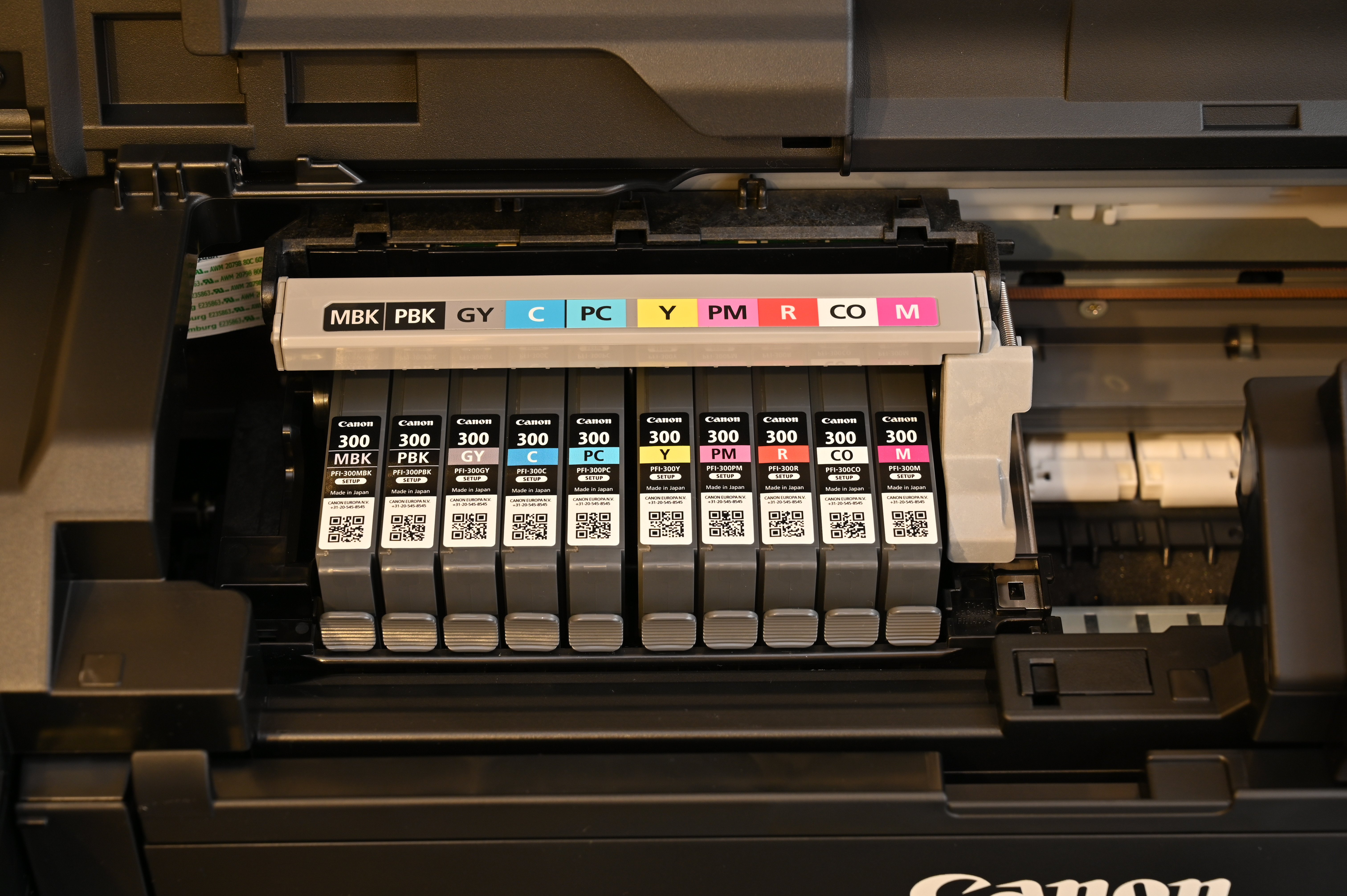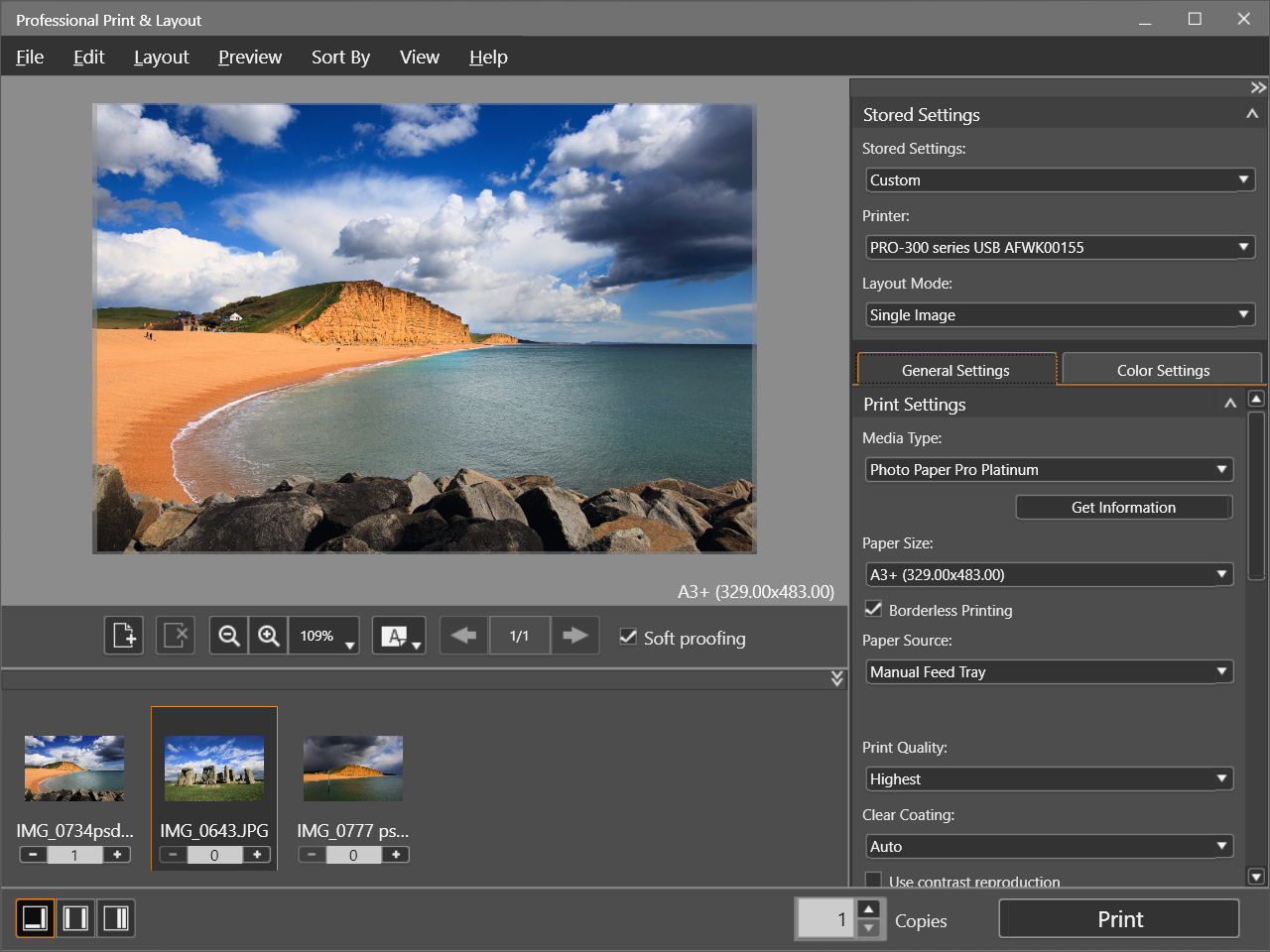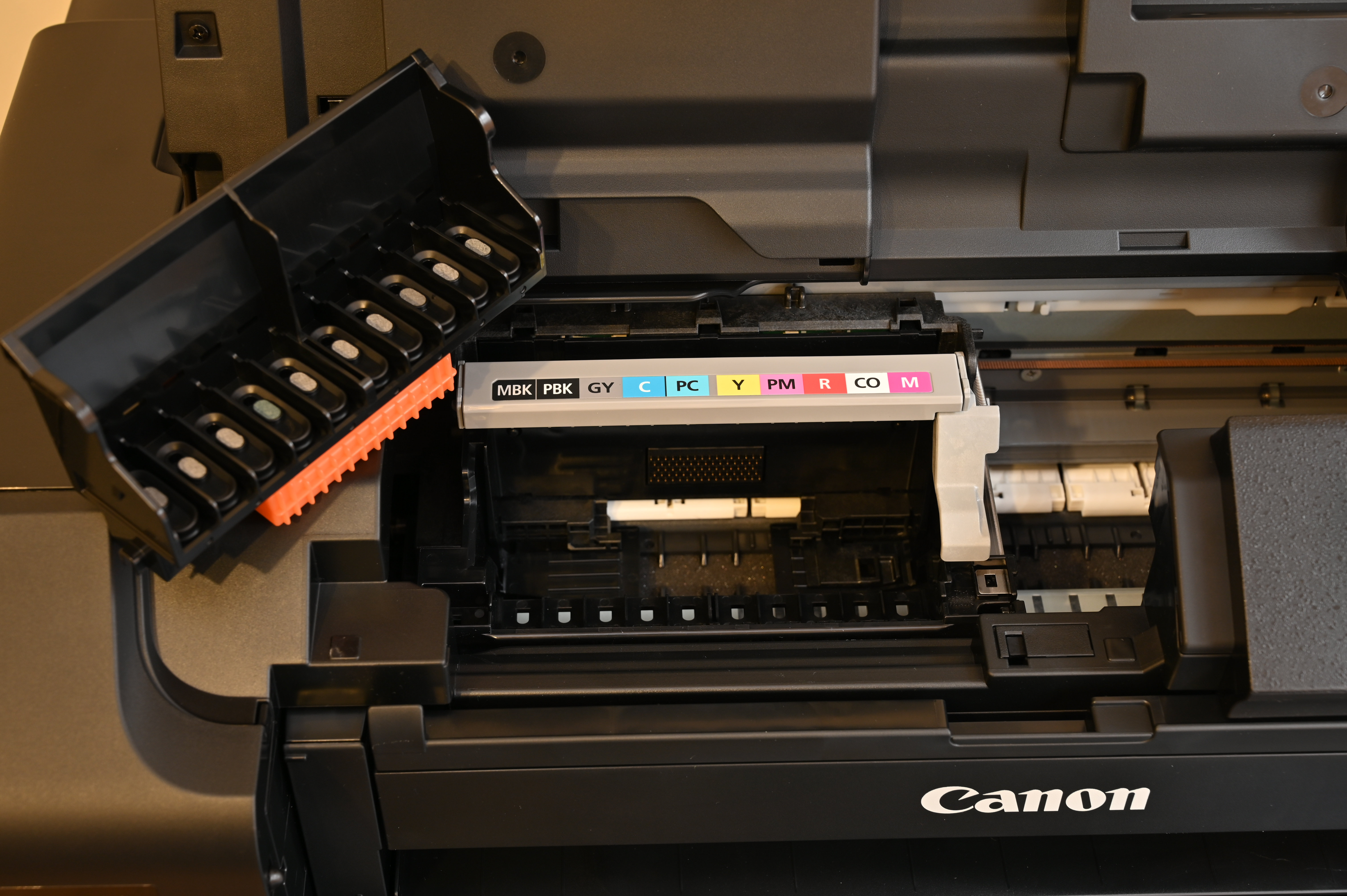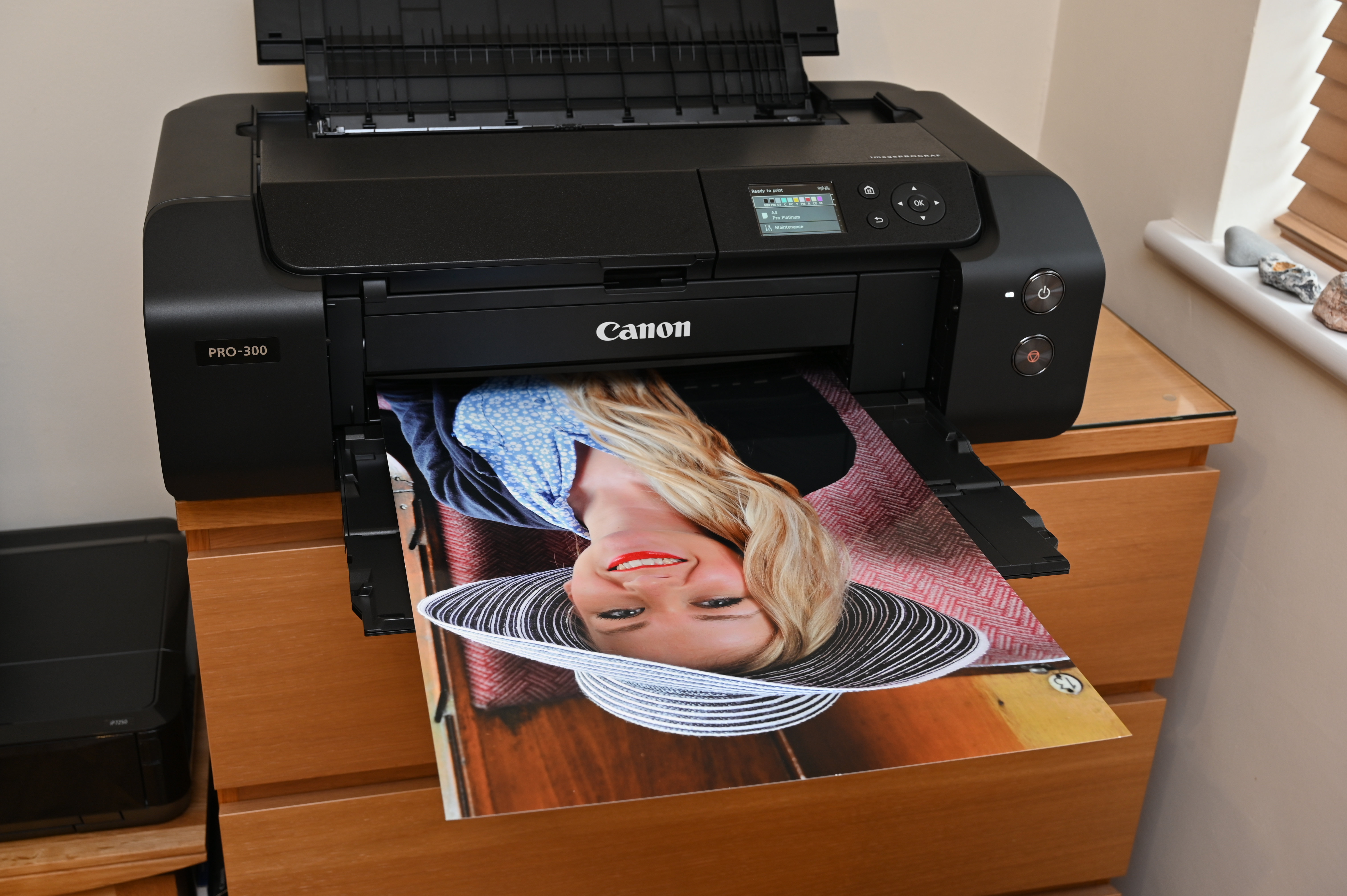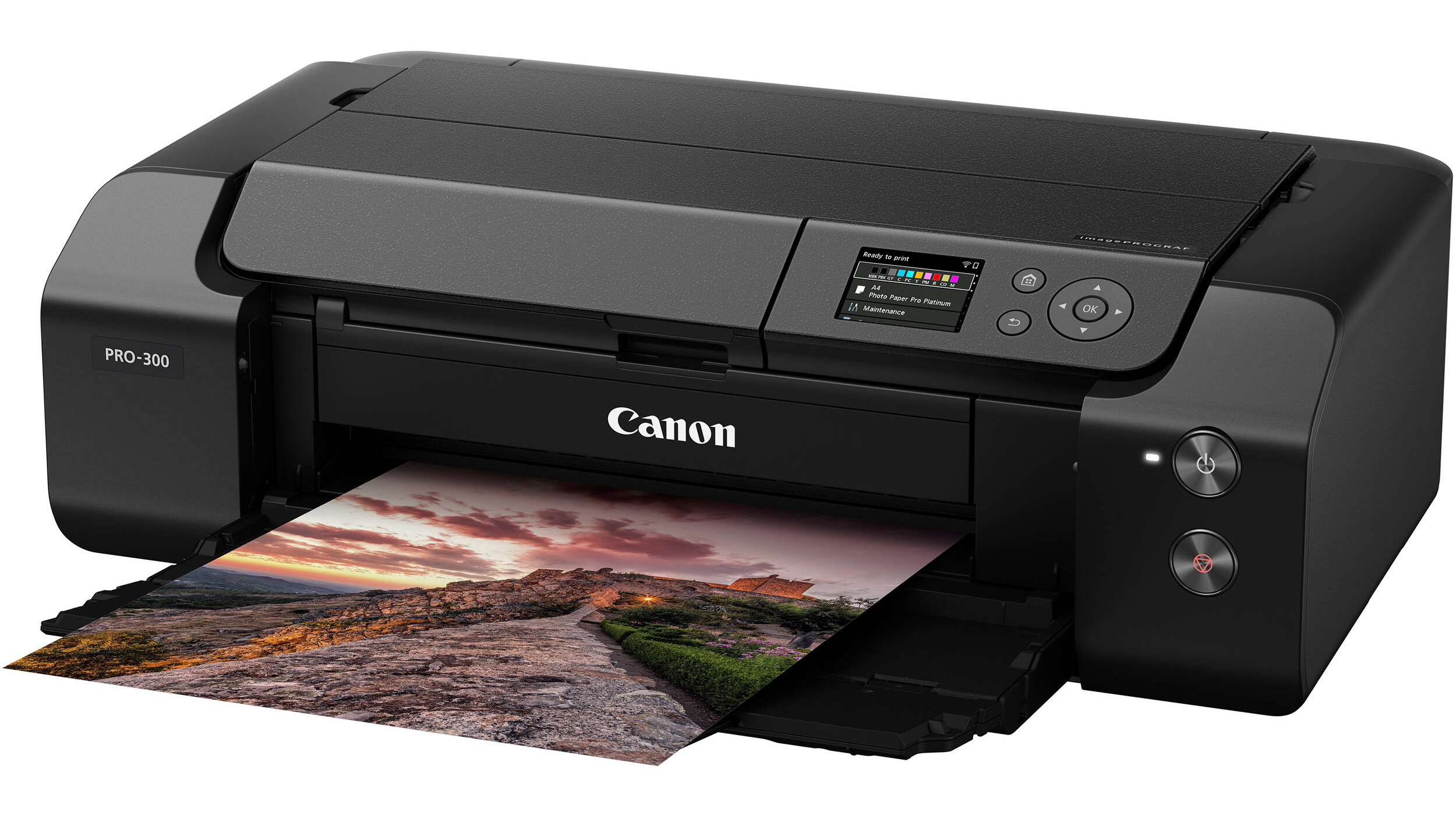Digital Camera World Verdict
We’ve always been very impressed with Canon’s 13-inch PIXMA PRO-10S pigment-based photo printer. The new imagePROGRAF PRO-300 offers even more. With upgraded LUCIA PRO inks, a 3-inch color menu screen, advanced companion software, the PRO-300 also enables borderless printing on matte and fine art media, instead of just glossy photo paper. It’s a real printing powerhouse.
Pros
- +
Sumptuous print quality on both glossy and matte media
- +
Superb black & white performance, along with vibrant colour
- +
Handy companion software for soft proofing and hard proofing
Cons
- -
As expected, print speeds are a little pedestrian compared with some dye-based printers
- -
Borderless printing on matte media isn’t risk-free
Why you can trust Digital Camera World
The Canon imagePROGRAF PRO-300 is a high quality A3+ photo printer, with a 13-inch printing width, designed to deliver fabulous looking output on both glossy and matte media. It replaces the PIXMA PRO-10S in Canon's printer lineup - a printer we already rate as one of the best photo printers - and it slots in below the larger, A2 format imagePROGRAF PRO-1000 large-format printer.
The two main choices for inkjet printers at this price point are dye-based or pigment-based inks. Dye-based printers are typically faster and work better with glossy photo paper, because the ink molecules are small enough to get fully absorbed beneath the shiny outer surface of the paper. Pigment-based inks work better with matte and fine-art media, as the results tend to look better and the ink is more robust and resistant to fading.
• See also Best Canon printers
Whichever ink option you choose, the sheer amount of fine detail in a printed A3 or 13x19-inch photo can be astonishing, with much more wow-factor than an A4 print. It enables you to print photos big enough to frame and hang on the wall, right from your own desktop.
Specifications
Model name: Canon imagePROGRAF PRO-300 (Canon Pixma Pro-200 in Australasia)
Inks/type: 10 pigment
Maximum paper width: 13 inches
The best camera deals, reviews, product advice, and unmissable photography news, direct to your inbox!
Max print size: A3+, 13x19 inches
Max print resolution: 4800x2400dpi
Input trays: 1x top, 1x rear
Display screen: 3-inch colour LCD
Interfaces: USB 2.0, Ethernet, Wi-Fi
Dimensions (WxDxH): 25.2 x 15.0 x 7.9in / 639x379x200mm
Weight: 14.4kg
Key features
The key to these Canon printers’ success in outputting top-quality results on both glossy and matte media is that they feature a ‘chroma optimizer’, contained in its own cartridge. This smooths out the finish when printing on glossy photo paper, so that there’s no difference in the reflectivity of different colors and tones. The ink range itself is very comprehensive, with ten separate cartridges in total. As well as the chroma optimizer, you get both matte and photo black inks, cyan, photo cyan, magenta, photo magenta, yellow, grey and red inks. They’re all from Canon’s latest LUCIA PRO line-up, giving the potential for a wide gamut (color space) with rich, vivid color rendition, as well as high-fidelity black & white photo printing.
Unlike Epson’s older SureColor SC-P600 13-inch pigment-based printer, the Canon includes dedicated channels for both photo black and matte black in its print head. This avoids the need to waste time, ink and therefore money, when switching between glossy and matte media.
Like the PRO-10S, the PRO-300 runs on cartridges that have a 14ml capacity. This should prove sufficient for around 30 to 60 borderless A3+ prints from each cartridge, although it naturally varies depending on the prominent colors and densities within your images. Ink costs typically average out to around $2.75/£3.70 per borderless A3+ photo print, which is pretty reasonable. Like most inkjet printers, the PRO-300 is supplied with ‘setup cartridges’ but, unlike with some printers, these have plenty of stamina instead of running dry after just a few prints.
An unusual feature of the PRO-300 is that it can create borderless prints on matte and fine-art media, rather than just on glossy photo paper. This can be a huge advantage but you need to disable the ‘safety margin regulation for paper size’ option, which is enabled by default in the printer driver. Indeed, Canon warns that ‘depending on the environment, conditions such as paper abrasion may cause paper stains or deterioration of print quality’. That said, we created a dozen or so borderless A3+ photo prints on Premium Matte photo paper and Premium Fine Art Smooth media with no ill effects.
Another bonus is that the printer caters to a wide range of media. This includes not only Canon’s impressive catalogue of fine-art papers, but also media from independent manufactures including the likes of Hahnemuhle, Canson and Awagami. What’s more, Canon’s Professional Print & Layout software is available as a free download, which works as a standalone app or as a plug-in for Canon Digital Photo Professional and Adobe Lightroom and Photoshop. This enables both soft proofing and hard proofing for different paper types, as well as giving you the option of applying individual adjustments to separate images that will be printed on the same page.
Build and handling
Weighing in at 14.4kg, the PRO-300 is no lightweight. It has a really solid chassis and build quality feels excellent throughout. Handling is enhanced by the inclusion of both a top feeder and a manual rear feeder. As well as catering to a range of popular print sizes, the printer can also output panoramic prints of up to 990.6cm in length. Another handling upgrade over the older PRO-10S is that the PRO-300 features a 3-inch color LCD screen. This comes complete with an adjacent set of navigation buttons, making it easy to set-up paper types for each feed path, as well as for carrying out routine maintenance and keeping an eye on ink levels.
Connectivity is good, with built-in Wi-Fi and ethernet as well as a high-speed USB port. A raft of cloud-based printing options includes AirPrint, Google Cloud Print, Windows 10 Mobile, Canon Print Service and PIXMA Cloud Link. The printer is pretty quiet in operation at around 40dB (A) and a ‘Quiet’ mode is also available via the menu system.
Performance
Print quality is absolutely outstanding. Color rendition is very rich and vibrant but also very true to life. The soft proofing and hard proofing facilities available in the companion Professional Print & Layout software make it easy to get exactly the results you want on different media, without wasting ink and paper. Black & white photo quality is equally as impressive as color output, with superb tonal definition and richness.
When you’re creating prints to last a lifetime, it seems a bit churlish to criticise a printer for a lack of speed. Indeed, any desktop printer is going to be a lot faster than ordering prints online and waiting for them to turn up in the post. Even so, if you need to create several prints in a hurry, speed can be an issue. Print speeds are very similar to those of the PRO-10S, which aren’t anywhere near as quick as for most dye-based printers, but still pretty nippy for a pigment-based printer.
An A3+ borderless print on glossy paper in the highest quality setting takes around 9m 30s for color, and about a minute less for black & white. At the standard quality setting, the same color print takes just 6m 30s to output. Top-quality borderless color output on A3+ Premium Fine Art Smooth takes longer, at just over 12m, whereas smaller A3 prints with a white border take around 10m 20s (Premium Fine Art Smooth) or 6m 50s (Premium Matte). For A4 borderless output on glossy paper, you’re looking at about 4m 30s in highest quality mode, and 3m 20s in standard mode.
Verdict
There’s a lot to be said for retaining full control over your images at every step of the process, from initial capture, through editing, to final output in print. Canon’s imagePROGRAF PRO-300 is the perfect tool for the job. It’s capable of spectacular and entirely consistent print quality, while the soft proofing and hard proofing facilities of its companion Professional Print & Layout software help to ensure that you get exactly the results you want. Considering the feature set, build quality, handling and performance, the printer is a great buy at the price, and its running costs are competitive as well. All in all, it’s a fabulous piece of kit.
Read more:
Best all-in-one printer for home working
The best portable printer for photos
Matthew Richards is a photographer and journalist who has spent years using and reviewing all manner of photo gear. He is Digital Camera World's principal lens reviewer – and has tested more primes and zooms than most people have had hot dinners!
His expertise with equipment doesn’t end there, though. He is also an encyclopedia when it comes to all manner of cameras, camera holsters and bags, flashguns, tripods and heads, printers, papers and inks, and just about anything imaging-related.
In an earlier life he was a broadcast engineer at the BBC, as well as a former editor of PC Guide.

